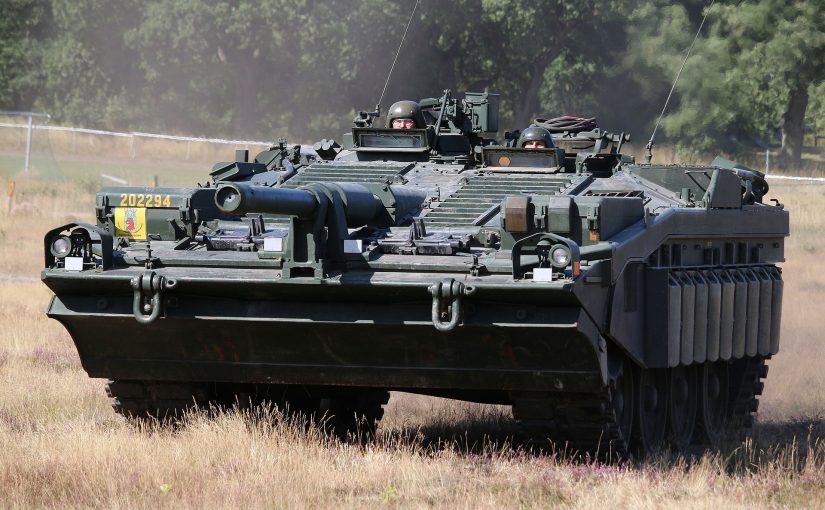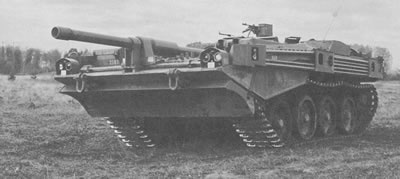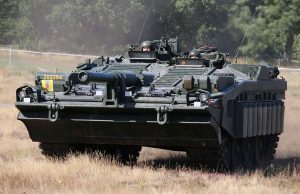
Last updated on February 19th, 2019 at 09:37 pm
Sweden’s Stridsvagn 103 main battle tank, also known as the S-tank, is a turretless tank. It is more of a defensive than an offensive weapon, and it was designed to help Sweden maintain its neutrality after World War II by defending against invasion.
Bofors began developing the Stridsvagn 103 MBT in 1958. The first two prototypes were finished in 1961.
Three hundred S-tanks were produced between 1966 and 1971.
The Stridsvagn 103 (or Strv 103) main battle tank has no turret.
Its main armament is a fixed 4.13 inch (105mm) gun that is fixed to the front of the hull.
To aim the gun, the tank has to be pivoted on its tracks and the angle of the tank’s hydropneumatic suspension has to be adjusted. The angle of the suspension can range from -10 degrees to +12 degrees.

The lack of a turret and movable gun means that the S-tank is not a very good offensive weapon.
Because the whole tank has to be pivoted in order to aim the gun, the gun cannot be fired while the Stridsvagn 103 MBT is on the move.
However, the S-tank’s having no turret means that it is easier to hide the tank during an ambush.

Secondary armament on the S-tank consist of two 0.3 inch (7.62mm) coaxial machine guns that are mounted at the front of the hull on the left and a 0.3 inch (7.62mm) anti-aircraft gun which is mounted on the left side of the commander’s cupola. The anti-aircraft gun can be fired from inside the tank.
There are also eight pairs of smoke dischargers and two Lyran flare launchers that are used for night fighting.
The S-tank has no infrared night vision and no NBC system.
There are four pairs of road wheels. The drive sprocket is in the front and the idler is in the back.
The Stridsvagn 103 main battle tank can be driven quickly backwards as well as forwards, so that after the tank fires at the enemy it can quickly drive backwards away from danger, with the front of the hull, which has the thickest armor, still facing the enemy so that it is protected from enemy gunfire as it retreats.
There are two drivers one for driving forwards and one for driving backwards. The backward driver has his own set of backward-facing controls.
The forward driver acts as the gunner and the backward driver operates the radio.
A three- man crew operates the S-tank – the commander, the forward driver/gunner and the backward driver/radio operator.
There is an automatic loader, so no human loader is needed.
The commander sits at the front right with the forward driver/gunner on his left. The backward driver/radio operator sits behind the forward driver.
The engine and the transmission are at the front of the tank, the magazine is in the back and the fighting compartment is in the center.
Unlike conventional tanks, which are powered by one engine, the Stridsvagn 103 main battle tank has a power pack with two engines – a Rolls Royce diesel engine and a Boeing gas turbine engine. The diesel engine was designed to be used on the road and the gas turbine engine was designed for use when the S-tank was in combat or when the tank was crossing rough terrain.
A second variant of the S-tank, the Stridsvagn 103B MBT, has a flotation screen that allows the tank to move through lakes and rivers on its tracks and a dozer blade that enables the S-tank to dig itself a fortified position underground for protection.
All of the original model (Stridsvagn 103A) tanks were eventually upgraded to have flotation screens and dozer blades.
In 1986, all of the S-tanks were upgraded to a third variant, the Stridsvagn 103C, which has a newer diesel engine, a modified transmission and a laser rangefinder.
A prototype of a later variant, the Stridsvagn 103D, which has an upgraded fire control system, was built in the 1990s. The Stridsvagn 103D never entered production.
The Stridsvagn 103 main battle tank was only ever used by the Swedish army. It has never seen combat and is no longer in service, having been replaced by Germany’s Leopard 2 main battle tank.
Stridsvagn 103 Main Battle Tank |
|
|---|---|
| Active: | 1966 |
| Crew: | 3 |
| Weight: | 39 tons (39,700kg) |
| Length: | Hull: 23ft 1in (7.04m); With gun forwards: 29ft 5in (8.99m) |
| Height: | 7ft 11in (2.43m) |
| Width: | 11ft 10in (3.63m) |
| Weapons: | Main – 41.3 inch (105mm) gun, Secondary – 2 x 0.3 inch (7.62mm) coaxial machine guns, 1 x 0.3 inch (7.62mm) anti-aircraft gun, 8 pairs of smoke grenade dischargers, 2 x Lyran flare launchers |
| Armor | Classified |
| Engine: | Boeing 553 gas turbine, 490 hp; Models A and B: Rolls-Royce K60 multi-fuel, 240hp: Model C: Detroit Diesel 6V-53T, 290 hp |
| Speed: | 31 mph (50kph) |
| Range: | 242 miles (390 km) |
